ABSTRACT
-
Original agricultural marketing channel is from farmer through middleman shipping to consumers. The middleman with market information could influence the market.
-
1981, Taiwan government passed the Agricultural Products Market Transaction Act (2012.11.28) to help setting agricultural marketing channel that is from farmers to agricultural products wholesales market then to retailer to consumers. The Act has two main parts: joint marketing and wholesale market.
-
The paper will discuss the relationship between agricultural cooperative and agricultural products marketing.
-
Pursuant to Cooperative Act, a cooperative need to register in Ministry of the Interior.
-
Since agricultural cooperatives are spread to whole country especially in agricultural area, a location of agricultural cooperative would be agricultural area located.
-
There are so many agricultural products in Taiwan, vegetable, fruit, livestock, fish, fish and so on. For simplicity, the paper focuses on vegetable and fruit as example.
-
The government had made lots of efforts to improve the transaction practices for vegetable and fruit, to assist cooperation group farmers in building assembling lots, purchasing equipment, as well as developing better grading and packaging methods financially.
-
Comparing to Cooperative, Cooperation Group does not need to register in Ministry of the Interior but Council of Agriculture, Agriculture and Food Agency.
-
There is quite a lot of improving space for performing cooperative agricultural marketing in Taiwan.
-
Farmer organization is not necessary an agricultural cooperative in Taiwan. Responsible government authorities for them are different, the Council of Agricultural and Ministry of the Interior respectively.
Key words: Joint Marketing, Agricultural Cooperative, Cooperation Group, Farmers’ Association
1. Introduction
Taiwan is island space about 3,618,995 hectare. 27.11% of Taiwan is plain region about 981,144ha. 27.12% of Taiwan is hilly about 981,424ha, and the remaining 45.77% is mountain. Cropland about 799,611ha (22.21%) most of them are located in the western part of Taiwan. There are two million farmers in Taiwan twenty three million people. According to Council of Agriculture statistics, it has 780 thousand farm families in 2014. The average cropland space per farm family is less than one hectare, the small scale farm. Cooperation for farmers one another is very important. The most farmlands are located in middle and south part in Taiwan. 70% People live in five main city areas. Since production area is in the south, transporting agricultural products to city area is an important agricultural marketing channel. Original agricultural marketing channel is from farmer (producer) through middleman shipping to consumers. The middleman with market information could influence the market.
In 1981, Taiwan government passed the Agricultural Products Market Transaction Act (2012.11.28) to help setting agricultural marketing channel that is from farmers to agricultural products wholesales market then to retailer to consumers. The Act has two main parts: joint marketing and wholesale market. The first is to make sure supply for market that is to help farmers to sale their agricultural products in the wholesale market. The wholesale market plays the role to collect agricultural products, and then distributes to the consumer by shipper and retailer. By the Act, the wholesale market need to deal with joint marketing agricultural products first to make sure those agricultural products shipping by joint marketing could sold out.
Joint marketing as the Agricultural Products Market Transaction Act Article 7:
Agricultural products marketing may be joint marketing performed by farmers’ organization, two forms as following: First, wholesales of supply and reselling or processing as purpose; Secondly, retails of supply to consumers as purpose; The aforesaid the agricultural products or areas may be performed joint marketing by farmers’ organization, and then may be performed by farmers themselves.
About the agricultural product wholesale market, the Agricultural Products Market Transaction Act Article 12:
Agricultural product wholesale markets are public utilities, their establishing and items of business matters should be proposed by competent authorities, and registered as budgets to subsidize. The aforesaid project proposed by local competent authorities, would be decided upon the merits of the case by central competent authority.
Since the topic is concerning cooperative, cooperatives development in Taiwan will be shown successively. Pursuant to Cooperatives Act (2011.06.15) Article 2 and 2-1: First, a cooperative is a legal person. Then, the regulating authorities of cooperatives refer to the Ministry of the Interior at the central level, the municipal governments at the municipal level, and the county (city) governments at the county (city) level. However, the target businesses of cooperatives shall be directed and supervised by the regulating authorities in charge of the target businesses. Obviously, the Ministry of the Interior is different from Council of Agriculture. It may raise some problem about performance of agricultural products joint marketing.
Then the paper will discuss the relationship between agricultural cooperative and agricultural products marketing. To review the Taiwan’s experience provides some improving affairs for agricultural marketing in the future. And the paper will offer some suggestions from reviewing Taiwan’s experience as the end.
2. Joint Marketing of Agricultural Products, Vegetable and Fruit
In 1982, Taiwan government passed Agricultural Products Market Transaction Act to set up the agricultural marketing channel, from farmers through agricultural products wholesale market then wholesaler retailer to consumers. It prevent farmers from middleman to sale their agricultural products in agricultural product wholesale market by joint marketing by farmers’ association, cooperation group, or agricultural cooperatives. Table 1 is shown 1993-2014 joint marketing vegetable and fruit and their percentage of agricultural product wholesale market transaction annually.
In 1982, Agricultural Products Transaction Act was passed. Eleven years later 1993, joint marketing vegetable with 211,796 ton was 0.095 of total agricultural product wholesale market transaction. For fruit with 137,509 ton was 0.0617 of total transaction. Both percentages are less than one tenth. There are some reasons will be discussed later in the paper.
From 1993 to 2014 vegetable and fruit transaction in agricultural products wholesale markets is around two million three hundred thousand ton. The highest is 2,542,240 ton in 2002, the lowest with 2,152,471 ton in 2005. The trend of total transaction seems stable keeping around two million some ton annually. For vegetable, joint marketing is successful from 211,796 ton (0.095) in 1993 increasing continuously to 464,956 ton (0.1838) in 2014 over two times as amount and percentage.
Table 1. 1993-2014 joint marketing vegetable and fruit and their percentage of agricultural products wholesale markets
.jpg)
Source: Taiwan Area Agricultural Products Wholesale Market Yearbook 2015.
However, the joint marketing for fruit seems not so well, from 137,509 ton (0.0617) in 1993, a little increasing to 185856 ton (0.0735) in 2014. Almost the same as the beginning in 1993, there is 1.18% different in 22years actually. As Agricultural Product Market Transaction Act, joint marketing may be performed by farmers’ organization. Table 2 and Table 3 are shown three main farmers’ organizations performing joint marketing separately.
From Table 2, National Farmers’ Association and Agricultural Production Cooperative are the major organizations of performing joint marketing of vegetable. Both of them are occupied about 40 some percentages of total amount of joint marketing vegetable. The third organization R. O. C. Fruit & Vegetable Cooperative performed less amount of joint marketing vegetable. However, the amount and the percentage are from 20,584 ton to 66,673 ton and 7% to 14% respectively. The percentage is two times more, as the amount is over third time more. It is worth to study the reason later.
Table 2. 2004-2014 Joint Marketing Vegetable by Three Main Organizations
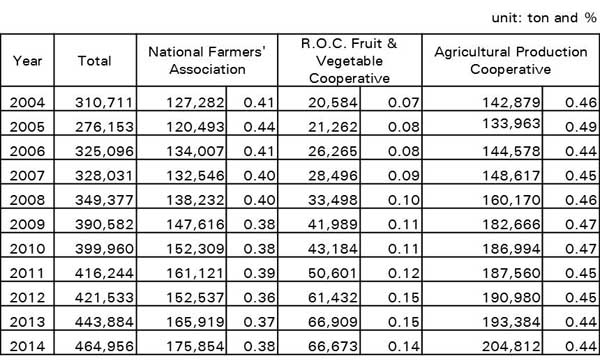
Source: Taiwan Area Agricultural Products Wholesale Market Yearbook, 2015
For fruit joint marketing, the situation is similar to vegetable. National Farmer’s Association and Agricultural Production Cooperative, their amount and percentage kept the same as the amount around 110,000 ton and 40,000 ton, and the percentage around 60% and 22% respectively. Furthermore, the R. O. C. Fruit & Vegetable Cooperative have similar situation as vegetable. The amount is from 9,515 ton to 20,572 ton as the percentage is from 5% to 11%. Both of them are increased over two times in the amount and percentage. Remarkably, there is the fourth main farmer organization to perform fruit joint marketing, named the Taiwan Fruit Marketing Cooperative. It concentrated about 10% of all and similar to National Farmers’ Association and Agricultural Production Cooperative, the amount and percentage both are kept the same from 2004 to 2014.
Table 3. Joint Marketing Fruit by Three Main Organizations
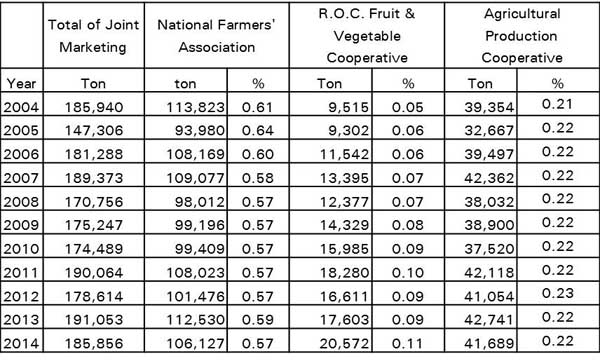
Source: Agriculture and Food Agency, Council of Agriculture, Executive Yuan, Taiwan.
Table 4 is shown supplier of joint marketing for vegetable and fruit. Obviously, the number of supplier will influence the amount of vegetable and fruit joint marketing. Supplier may be overlapped between those farmer organizations.
Table 4. Supplier of Joint Marketing of Three Main Organizations
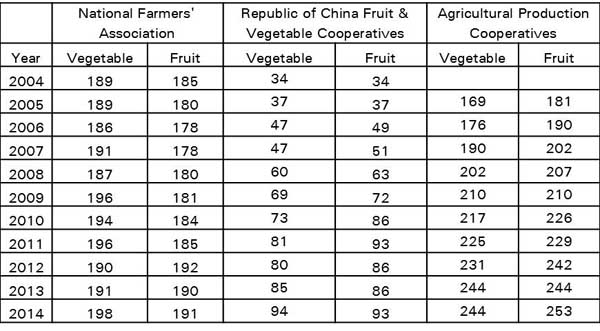
Source: National Farmers' Association, Republic of China Fruit & Vegetable Cooperative, and Agricultural Production Cooperatives.
3. Agricultural Cooperative in Taiwan
Pursuant to Cooperative Act, a cooperative need to register in Ministry of the Interior. There are five different agricultural cooperatives: production, marketing, labor, supply, and producers’ utility in single-purpose agricultural cooperative. Another agricultural marketing related cooperative is cooperative farm. Concerning agricultural marketing, production cooperative, marketing cooperative, and cooperative farm are the paper interested only. Table 5 is shown the number and membership of agricultural cooperative in 2013. There are 983 agricultural cooperatives and 225 cooperative farms, 1,208 unit cooperative and federation totally. For membership, there are 169,044 persons, agricultural cooperative with 148,868 persons and cooperative farm with 20,176 persons. At the time, there are 1,564 legal persons total, agricultural cooperative with 1,537 legal persons and cooperative farm with 27 legal persons.
Table 5. Number and Membership of Agricultural Cooperatives, 2013
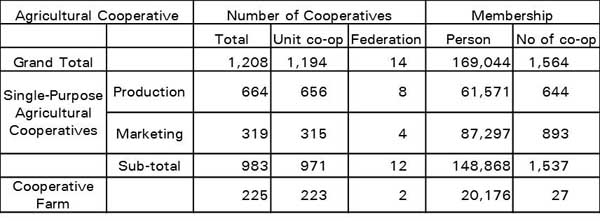
Source: Cooperative Enterprise Yearbook, 2014
Table 6 is shown the number and membership of agricultural production cooperatives from 2003 to 2013. The number of agricultural production cooperatives is 287 in 2003 and 664 in 2013, increasing almost two and half times. The membership of agricultural production cooperatives, the number of cooperatives is 184 in 2003 and 644 in 2013, increasing about three and half times. However, the person of membership is 68,693 in 2003 decreasing to 61,571 in 2013. Therefore, the person per cooperative averagely is 373 persons per cooperative in 2003 shrinking to 96 persons per cooperative in 2013.
Table 6. Number & Membership of Agricultural Production Cooperatives

Source: Cooperative Enterprise Yearbook, 2014
Table 7 is shown number and membership of marketing cooperatives from 2003 to 2013. The number of marketing cooperatives is 134 in 2003 and 328 in 2013, about 2.4 times increasing. The membership of marketing cooperatives, number of cooperatives is 485 in 2003 and 893 in 2013. In 2004, the data is missing and 80 in 2005 is an outliner. It seems the data is not precise in two years. The person per cooperative is 208 (100,858/485) in 2003 and 105 (93,370/893) in 2013, the amount almost half of 208.
Table 7. 2003-2013 Number & Membership of Marketing Cooperatives
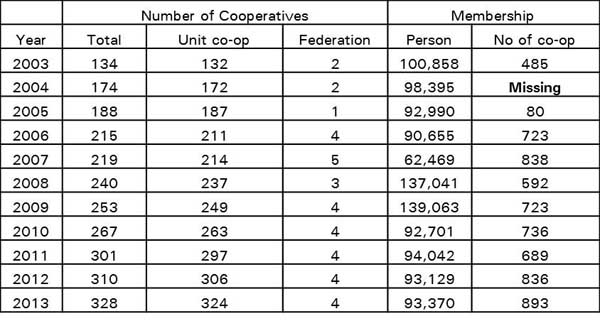
Source: Cooperative Enterprise Yearbook, 2014
Since agricultural cooperatives are spread to whole country especially in agricultural area, a location of agricultural cooperative would be agricultural area located. Table 8 is shown number and membership of cooperative farms by locality. Yunlin H. with 64 cooperative farms is the most number in Taiwan. It is one of important vegetable production areas. Kaohsiung C. with 27 cooperative farms, Taoyuan H. (now it is City) with 36 cooperative farms, and Nantou H. with 27 cooperative farms, they are main fruit production areas in Taiwan. Therefore, all of them have more membership with more people comparing with other areas in Taiwan.
Table 8. Number and Membership of Cooperative Farms by Locality in 2013
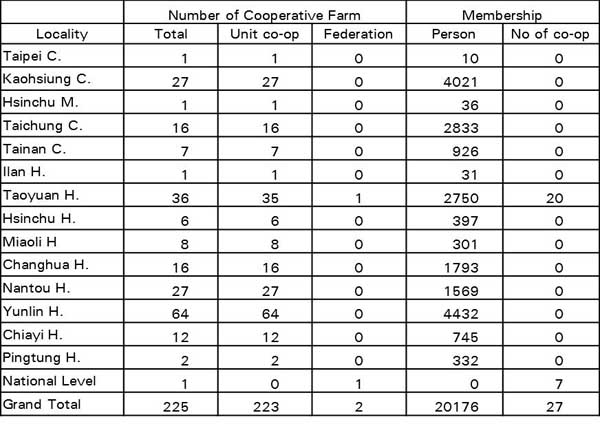
Source: Cooperative Enterprise Yearbook, 2014
Table 9 is shown number and membership of cooperatives farms 1990 to 2013. The number of cooperative farms is around two hundred, two decades not much change. The membership of cooperative farms is around twenty thousand persons keeping stable from 1990 to 2013. The membership of cooperative farms, the person is 21,809 in 1990 and 20,176 in 2013, not much different from 1990 to 2013. However, the person per farm is 217 (21,809/85) in 1990, and 747 (20,176/27) in 2013, increasing three times (747/217) in 24 years 1990 to 2013.
Table 9. 1990-2013 Number & Membership of Cooperative Farms

Source: Cooperative Enterprise Yearbook, 2014
Pursuant to Cooperative Act Article 3, there are three kinds of agricultural cooperative, production, marketing and cooperative farm. Agricultural production and marketing cooperative are single-purpose agricultural cooperative so that their register may be easier than cooperative farm. Therefore, the number and membership of cooperative farm in 2013 are almost the same as them in 1990. Since there is any data concerning agricultural marketing amount of vegetable or fruit, it is difficult to judge which kind of cooperative with better performance of marketing. Even though, marketing cooperatives are not necessary with better performance of marketing than production cooperatives.Source: Cooperative Enterprise Yearbook, 2014
4. The Role of Government in Agricultural Marketing
There are so many agricultural products in Taiwan, vegetable, fruit, livestock, fish, fish and so on. For simplicity, the paper focuses on vegetable and fruit as example. In 2015 Taiwan Area Agricultural Products Wholesale Market Yearbook, it was reported to improve vegetable marketing system. Taiwan government had assisted and guided farmer organizations to carry out cooperative marketing programs for shipping vegetable to the wholesale markets in major consumption area since June 1973. After the inauguration of Taiwan Fruit and Vegetable Marketing Corporation (renamed as Taipei Agricultural Product Corporation in June 1984), amount of vegetable and fruit cooperative marketing had increased annually as the Agricultural Products Market Transaction Act was passed in 1982.
The government had made lots of efforts to improve the transaction practices for vegetable and fruit, to assist cooperation group farmers in building assembling lots, purchasing equipment, as well as developing better grading and packaging methods financially. Hence, cooperative marketing has been widely adopted by the producers in major vegetable production areas. There are four main farmers’ organizations, the National Farmers’ Association, the Agricultural Production Cooperatives, the Republic of China Fruit and Vegetable Cooperative (as mentioned above), and the Taiwan Fruit Marketing Cooperative. Their suppliers are more than 500 units totally. As in Table 1, there were 464,956 ton the amount of joint market by farmer cooperatives in 2014. There were 344,895 ton (74.2%) shipped to the Taipei Agricultural Products Wholesale Market, 19,329 ton (4.2%) to the Kaohsiung Agricultural Products Wholesale Market, the rest 100,732 ton (21.6%) to the other agricultural products wholesale markets.
As the report, it seems the government did a good job about agricultural marketing. However. It is not fair enough to say that. The first, the total annual transaction is 2,529,361 ton vegetable and fruit in 2014. It is only 18.4% vegetable cooperative marketing by joint marketing. As shown in Table 2, why the National Farmers’ Association and the Agricultural Production Cooperative are staying the same as percentage, even though the volumes increasing a little from 2004 to 2014. The further research is needed to figure out solutions. The other is the cooperative (joint) marketing volumes concentrated in Taipei Agricultural Products Wholesale Market heavily. It may cause farmer organization losing bargain power and competition.
For fruit cooperative marketing, cooperative fruit marketing system was initiated in 1974, one year later than vegetable. As shown in Table 1, the volumes of fruit joint marketing is from 137,509 ton in 1993 increasing to 185,856 ton in 2014, only 48,347 ton differently. The worse situation of fruit cooperative marketing, it is only 7.4% (185,856/2,529,361) of total vegetable and fruit transaction in 2014. There are four main farmer organizations to perform fruit cooperative marketing as above. There are 129,747 ton (69.8%) shipped to the Taipei Agricultural Product Wholesale Market, 47,730 ton (25.7%) to the New Taipei City Agricultural Product Wholesale Market, the rest 8,379 ton to the other wholesale markets. The situation is similar to vegetable cooperative marketing and fruit cooperative marketing getting more concentrated and is worse than vegetable in market distribution and market share.
The Government amended Agricultural Development Act (2010, 12, 8) Article 3 in February 7, 2003 to add Item 16 the definition of Cooperation Group as: An agricultural organization which is voluntarily formed and managed by farmers together whose lands are adjacent or close to each other, or manage the same type of agricultural activities. Actually, there were some Cooperation Group in agricultural production region before 2003. Since they did not have legal position, the Government could not support them well. In other word, the total amount of Cooperation Group was over six thousand, forcing government to face the situation, see Table 10.
In Table 10, the number of Cooperation Group is 154 in 1991, and 6,274 in 2015. The members of Cooperation Group are 2,682 in 1991 and 128,786 in 2015. Even though, the government amended the Agricultural Development Act in 2003, the number and members were reached the top in 2005, the number 7,123 and members 132,023 respectively. Up to now, both are kept stable on six thousand and one hundred twelve thousand number and member. Comparing to Cooperative, Cooperation Group does not need to register in Ministry of the Interior but Council of Agriculture, Agriculture and Food Agency. In Table 10, vegetable and fruit cooperation group have similar number and member, two thousand in number and forty thousand in member. One thing different is the space of cooperation group, fruit almost twice vegetable since producing fruit need more space.
Table 10. Cooperation Group Whole Country, Vegetable and Fruit
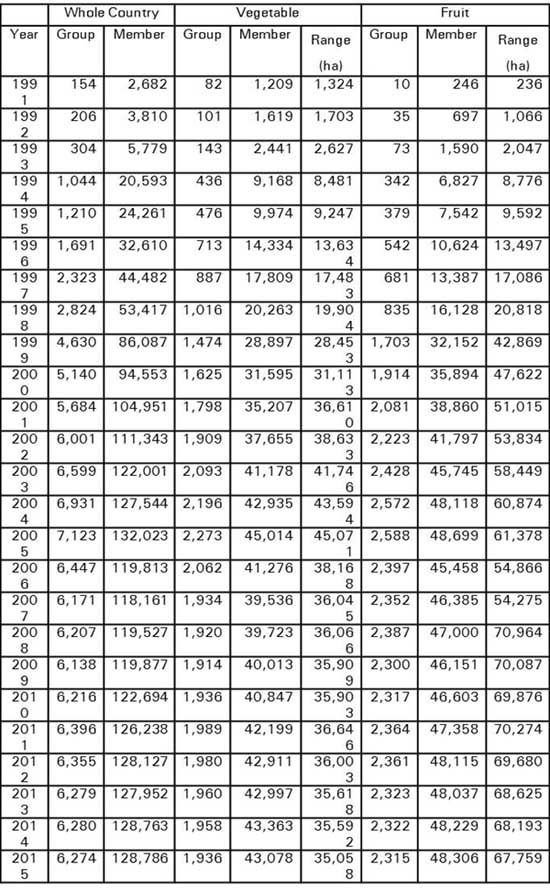
Source: Agriculture and Food Agency, Council of Agriculture, Executive Yuan, Taiwan. Agricultural Cooperation Group Information Service System as http://agrpmg.afa.gov.tw/agr-Sed/agrJsp/main.jsp?page=15
5. Discussion on Taiwan Agricultural Marketing and Cooperative
(1) Market Share:
According to Table 1, vegetable and fruit joint marketing volumes are about one quarter of transaction in agricultural products wholesale markets. The number is obtained by Equation (1) and as follows.

Table 5 and Table 10, farmer population of agricultural cooperatives and cooperation groups is about 8.7% of whole country farmer population, in Taiwan Agricultural Yearbook 2013. It is found by the following Equation (2).

There is 799,611 hectares in Taiwan cropland according to Taiwan Agricultural Yearbook 2013. From Table 10, about 12.9% cropland is joined in cooperation group. The percentage is provided by the Equation (3).

Therefore, there is quite a lot of improving space for performing cooperative agricultural marketing in Taiwan.
(2) Farmer Organization and Agricultural Cooperative
Farmer organization is not necessary an agricultural cooperative in Taiwan. Responsible government authorities for them are different, the Council of Agricultural and Ministry of the Interior respectively. One challenge is how to perform agricultural marketing well for both of them.
(3) Agricultural Products Wholesale Market
Pursuant to Agricultural Products Market Transaction Act Article 25: The transaction modes of the agricultural product wholesale market are to auction, to negotiate prices, to mark the prices, to enter a bit. The supplier may specify the lowest transaction price. Joint marketing or cooperative agricultural products suppliers are prefer to ship their products to an agricultural products wholesale market with auction transaction mode.
(4) Farmer Education and Training
Farmers are the most important factor of performing better agricultural marketing. Farmers organize farmers’ association and register as agricultural cooperative. Therefore, farmer education and training is very critical for making sure farmer organizations and agricultural cooperatives function well. Therefore, the program for farmer education and training is necessary and helpful for agricultural marketing.
Reference
-
Agricultural Production Cooperative.
-
Agricultural Products Market Transaction Act (2012, 11, 28).
-
Agriculture and Food Agency, Council of Agriculture, Executive Yuan, Taiwan.
-
Agriculture and Food Agency, Council of Agriculture, Executive Yuan, Taiwan. Agricultural Cooperation Group Information Service System as http://agrpmg.afa.gov.tw/agr-Sed/agrJsp/main.jsp?page=15
-
Cooperative Enterprise Yearbook, 2014.
-
Cooperatives Act (2011, 6, 15).
-
National Farmers’ Association.
-
Republic of China Fruit and Vegetable Cooperative.
-
Taiwan Agricultural Yearbook, 2014.
-
Taiwan Area Agricultural Products Wholesale Market Yearbook 2015.
|
Submitted as a resource paper for the FFTC-NACF International Seminar on Improving Food Marketing Efficiency—the Role of Agricultural Cooperatives, Sept. 14-18, NACF, Seoul, Korea |


The Impact of Agricultural Cooperatives on Agricultural Marketing: Taiwan's Experience
ABSTRACT
Key words: Joint Marketing, Agricultural Cooperative, Cooperation Group, Farmers’ Association
1. Introduction
Taiwan is island space about 3,618,995 hectare. 27.11% of Taiwan is plain region about 981,144ha. 27.12% of Taiwan is hilly about 981,424ha, and the remaining 45.77% is mountain. Cropland about 799,611ha (22.21%) most of them are located in the western part of Taiwan. There are two million farmers in Taiwan twenty three million people. According to Council of Agriculture statistics, it has 780 thousand farm families in 2014. The average cropland space per farm family is less than one hectare, the small scale farm. Cooperation for farmers one another is very important. The most farmlands are located in middle and south part in Taiwan. 70% People live in five main city areas. Since production area is in the south, transporting agricultural products to city area is an important agricultural marketing channel. Original agricultural marketing channel is from farmer (producer) through middleman shipping to consumers. The middleman with market information could influence the market.
In 1981, Taiwan government passed the Agricultural Products Market Transaction Act (2012.11.28) to help setting agricultural marketing channel that is from farmers to agricultural products wholesales market then to retailer to consumers. The Act has two main parts: joint marketing and wholesale market. The first is to make sure supply for market that is to help farmers to sale their agricultural products in the wholesale market. The wholesale market plays the role to collect agricultural products, and then distributes to the consumer by shipper and retailer. By the Act, the wholesale market need to deal with joint marketing agricultural products first to make sure those agricultural products shipping by joint marketing could sold out.
Joint marketing as the Agricultural Products Market Transaction Act Article 7:
Agricultural products marketing may be joint marketing performed by farmers’ organization, two forms as following: First, wholesales of supply and reselling or processing as purpose; Secondly, retails of supply to consumers as purpose; The aforesaid the agricultural products or areas may be performed joint marketing by farmers’ organization, and then may be performed by farmers themselves.
About the agricultural product wholesale market, the Agricultural Products Market Transaction Act Article 12:
Agricultural product wholesale markets are public utilities, their establishing and items of business matters should be proposed by competent authorities, and registered as budgets to subsidize. The aforesaid project proposed by local competent authorities, would be decided upon the merits of the case by central competent authority.
Since the topic is concerning cooperative, cooperatives development in Taiwan will be shown successively. Pursuant to Cooperatives Act (2011.06.15) Article 2 and 2-1: First, a cooperative is a legal person. Then, the regulating authorities of cooperatives refer to the Ministry of the Interior at the central level, the municipal governments at the municipal level, and the county (city) governments at the county (city) level. However, the target businesses of cooperatives shall be directed and supervised by the regulating authorities in charge of the target businesses. Obviously, the Ministry of the Interior is different from Council of Agriculture. It may raise some problem about performance of agricultural products joint marketing.
Then the paper will discuss the relationship between agricultural cooperative and agricultural products marketing. To review the Taiwan’s experience provides some improving affairs for agricultural marketing in the future. And the paper will offer some suggestions from reviewing Taiwan’s experience as the end.
2. Joint Marketing of Agricultural Products, Vegetable and Fruit
In 1982, Taiwan government passed Agricultural Products Market Transaction Act to set up the agricultural marketing channel, from farmers through agricultural products wholesale market then wholesaler retailer to consumers. It prevent farmers from middleman to sale their agricultural products in agricultural product wholesale market by joint marketing by farmers’ association, cooperation group, or agricultural cooperatives. Table 1 is shown 1993-2014 joint marketing vegetable and fruit and their percentage of agricultural product wholesale market transaction annually.
In 1982, Agricultural Products Transaction Act was passed. Eleven years later 1993, joint marketing vegetable with 211,796 ton was 0.095 of total agricultural product wholesale market transaction. For fruit with 137,509 ton was 0.0617 of total transaction. Both percentages are less than one tenth. There are some reasons will be discussed later in the paper.
From 1993 to 2014 vegetable and fruit transaction in agricultural products wholesale markets is around two million three hundred thousand ton. The highest is 2,542,240 ton in 2002, the lowest with 2,152,471 ton in 2005. The trend of total transaction seems stable keeping around two million some ton annually. For vegetable, joint marketing is successful from 211,796 ton (0.095) in 1993 increasing continuously to 464,956 ton (0.1838) in 2014 over two times as amount and percentage.
Table 1. 1993-2014 joint marketing vegetable and fruit and their percentage of agricultural products wholesale markets
Source: Taiwan Area Agricultural Products Wholesale Market Yearbook 2015.
However, the joint marketing for fruit seems not so well, from 137,509 ton (0.0617) in 1993, a little increasing to 185856 ton (0.0735) in 2014. Almost the same as the beginning in 1993, there is 1.18% different in 22years actually. As Agricultural Product Market Transaction Act, joint marketing may be performed by farmers’ organization. Table 2 and Table 3 are shown three main farmers’ organizations performing joint marketing separately.
From Table 2, National Farmers’ Association and Agricultural Production Cooperative are the major organizations of performing joint marketing of vegetable. Both of them are occupied about 40 some percentages of total amount of joint marketing vegetable. The third organization R. O. C. Fruit & Vegetable Cooperative performed less amount of joint marketing vegetable. However, the amount and the percentage are from 20,584 ton to 66,673 ton and 7% to 14% respectively. The percentage is two times more, as the amount is over third time more. It is worth to study the reason later.
Table 2. 2004-2014 Joint Marketing Vegetable by Three Main Organizations
Source: Taiwan Area Agricultural Products Wholesale Market Yearbook, 2015
For fruit joint marketing, the situation is similar to vegetable. National Farmer’s Association and Agricultural Production Cooperative, their amount and percentage kept the same as the amount around 110,000 ton and 40,000 ton, and the percentage around 60% and 22% respectively. Furthermore, the R. O. C. Fruit & Vegetable Cooperative have similar situation as vegetable. The amount is from 9,515 ton to 20,572 ton as the percentage is from 5% to 11%. Both of them are increased over two times in the amount and percentage. Remarkably, there is the fourth main farmer organization to perform fruit joint marketing, named the Taiwan Fruit Marketing Cooperative. It concentrated about 10% of all and similar to National Farmers’ Association and Agricultural Production Cooperative, the amount and percentage both are kept the same from 2004 to 2014.
Table 3. Joint Marketing Fruit by Three Main Organizations
Source: Agriculture and Food Agency, Council of Agriculture, Executive Yuan, Taiwan.
Table 4 is shown supplier of joint marketing for vegetable and fruit. Obviously, the number of supplier will influence the amount of vegetable and fruit joint marketing. Supplier may be overlapped between those farmer organizations.
Table 4. Supplier of Joint Marketing of Three Main Organizations
Source: National Farmers' Association, Republic of China Fruit & Vegetable Cooperative, and Agricultural Production Cooperatives.
3. Agricultural Cooperative in Taiwan
Pursuant to Cooperative Act, a cooperative need to register in Ministry of the Interior. There are five different agricultural cooperatives: production, marketing, labor, supply, and producers’ utility in single-purpose agricultural cooperative. Another agricultural marketing related cooperative is cooperative farm. Concerning agricultural marketing, production cooperative, marketing cooperative, and cooperative farm are the paper interested only. Table 5 is shown the number and membership of agricultural cooperative in 2013. There are 983 agricultural cooperatives and 225 cooperative farms, 1,208 unit cooperative and federation totally. For membership, there are 169,044 persons, agricultural cooperative with 148,868 persons and cooperative farm with 20,176 persons. At the time, there are 1,564 legal persons total, agricultural cooperative with 1,537 legal persons and cooperative farm with 27 legal persons.
Table 5. Number and Membership of Agricultural Cooperatives, 2013
Source: Cooperative Enterprise Yearbook, 2014
Table 6 is shown the number and membership of agricultural production cooperatives from 2003 to 2013. The number of agricultural production cooperatives is 287 in 2003 and 664 in 2013, increasing almost two and half times. The membership of agricultural production cooperatives, the number of cooperatives is 184 in 2003 and 644 in 2013, increasing about three and half times. However, the person of membership is 68,693 in 2003 decreasing to 61,571 in 2013. Therefore, the person per cooperative averagely is 373 persons per cooperative in 2003 shrinking to 96 persons per cooperative in 2013.
Table 6. Number & Membership of Agricultural Production Cooperatives
Source: Cooperative Enterprise Yearbook, 2014
Table 7 is shown number and membership of marketing cooperatives from 2003 to 2013. The number of marketing cooperatives is 134 in 2003 and 328 in 2013, about 2.4 times increasing. The membership of marketing cooperatives, number of cooperatives is 485 in 2003 and 893 in 2013. In 2004, the data is missing and 80 in 2005 is an outliner. It seems the data is not precise in two years. The person per cooperative is 208 (100,858/485) in 2003 and 105 (93,370/893) in 2013, the amount almost half of 208.
Table 7. 2003-2013 Number & Membership of Marketing Cooperatives
Source: Cooperative Enterprise Yearbook, 2014
Since agricultural cooperatives are spread to whole country especially in agricultural area, a location of agricultural cooperative would be agricultural area located. Table 8 is shown number and membership of cooperative farms by locality. Yunlin H. with 64 cooperative farms is the most number in Taiwan. It is one of important vegetable production areas. Kaohsiung C. with 27 cooperative farms, Taoyuan H. (now it is City) with 36 cooperative farms, and Nantou H. with 27 cooperative farms, they are main fruit production areas in Taiwan. Therefore, all of them have more membership with more people comparing with other areas in Taiwan.
Table 8. Number and Membership of Cooperative Farms by Locality in 2013
Source: Cooperative Enterprise Yearbook, 2014
Table 9 is shown number and membership of cooperatives farms 1990 to 2013. The number of cooperative farms is around two hundred, two decades not much change. The membership of cooperative farms is around twenty thousand persons keeping stable from 1990 to 2013. The membership of cooperative farms, the person is 21,809 in 1990 and 20,176 in 2013, not much different from 1990 to 2013. However, the person per farm is 217 (21,809/85) in 1990, and 747 (20,176/27) in 2013, increasing three times (747/217) in 24 years 1990 to 2013.
Table 9. 1990-2013 Number & Membership of Cooperative Farms
Source: Cooperative Enterprise Yearbook, 2014
Pursuant to Cooperative Act Article 3, there are three kinds of agricultural cooperative, production, marketing and cooperative farm. Agricultural production and marketing cooperative are single-purpose agricultural cooperative so that their register may be easier than cooperative farm. Therefore, the number and membership of cooperative farm in 2013 are almost the same as them in 1990. Since there is any data concerning agricultural marketing amount of vegetable or fruit, it is difficult to judge which kind of cooperative with better performance of marketing. Even though, marketing cooperatives are not necessary with better performance of marketing than production cooperatives.Source: Cooperative Enterprise Yearbook, 2014
4. The Role of Government in Agricultural Marketing
There are so many agricultural products in Taiwan, vegetable, fruit, livestock, fish, fish and so on. For simplicity, the paper focuses on vegetable and fruit as example. In 2015 Taiwan Area Agricultural Products Wholesale Market Yearbook, it was reported to improve vegetable marketing system. Taiwan government had assisted and guided farmer organizations to carry out cooperative marketing programs for shipping vegetable to the wholesale markets in major consumption area since June 1973. After the inauguration of Taiwan Fruit and Vegetable Marketing Corporation (renamed as Taipei Agricultural Product Corporation in June 1984), amount of vegetable and fruit cooperative marketing had increased annually as the Agricultural Products Market Transaction Act was passed in 1982.
The government had made lots of efforts to improve the transaction practices for vegetable and fruit, to assist cooperation group farmers in building assembling lots, purchasing equipment, as well as developing better grading and packaging methods financially. Hence, cooperative marketing has been widely adopted by the producers in major vegetable production areas. There are four main farmers’ organizations, the National Farmers’ Association, the Agricultural Production Cooperatives, the Republic of China Fruit and Vegetable Cooperative (as mentioned above), and the Taiwan Fruit Marketing Cooperative. Their suppliers are more than 500 units totally. As in Table 1, there were 464,956 ton the amount of joint market by farmer cooperatives in 2014. There were 344,895 ton (74.2%) shipped to the Taipei Agricultural Products Wholesale Market, 19,329 ton (4.2%) to the Kaohsiung Agricultural Products Wholesale Market, the rest 100,732 ton (21.6%) to the other agricultural products wholesale markets.
As the report, it seems the government did a good job about agricultural marketing. However. It is not fair enough to say that. The first, the total annual transaction is 2,529,361 ton vegetable and fruit in 2014. It is only 18.4% vegetable cooperative marketing by joint marketing. As shown in Table 2, why the National Farmers’ Association and the Agricultural Production Cooperative are staying the same as percentage, even though the volumes increasing a little from 2004 to 2014. The further research is needed to figure out solutions. The other is the cooperative (joint) marketing volumes concentrated in Taipei Agricultural Products Wholesale Market heavily. It may cause farmer organization losing bargain power and competition.
For fruit cooperative marketing, cooperative fruit marketing system was initiated in 1974, one year later than vegetable. As shown in Table 1, the volumes of fruit joint marketing is from 137,509 ton in 1993 increasing to 185,856 ton in 2014, only 48,347 ton differently. The worse situation of fruit cooperative marketing, it is only 7.4% (185,856/2,529,361) of total vegetable and fruit transaction in 2014. There are four main farmer organizations to perform fruit cooperative marketing as above. There are 129,747 ton (69.8%) shipped to the Taipei Agricultural Product Wholesale Market, 47,730 ton (25.7%) to the New Taipei City Agricultural Product Wholesale Market, the rest 8,379 ton to the other wholesale markets. The situation is similar to vegetable cooperative marketing and fruit cooperative marketing getting more concentrated and is worse than vegetable in market distribution and market share.
The Government amended Agricultural Development Act (2010, 12, 8) Article 3 in February 7, 2003 to add Item 16 the definition of Cooperation Group as: An agricultural organization which is voluntarily formed and managed by farmers together whose lands are adjacent or close to each other, or manage the same type of agricultural activities. Actually, there were some Cooperation Group in agricultural production region before 2003. Since they did not have legal position, the Government could not support them well. In other word, the total amount of Cooperation Group was over six thousand, forcing government to face the situation, see Table 10.
In Table 10, the number of Cooperation Group is 154 in 1991, and 6,274 in 2015. The members of Cooperation Group are 2,682 in 1991 and 128,786 in 2015. Even though, the government amended the Agricultural Development Act in 2003, the number and members were reached the top in 2005, the number 7,123 and members 132,023 respectively. Up to now, both are kept stable on six thousand and one hundred twelve thousand number and member. Comparing to Cooperative, Cooperation Group does not need to register in Ministry of the Interior but Council of Agriculture, Agriculture and Food Agency. In Table 10, vegetable and fruit cooperation group have similar number and member, two thousand in number and forty thousand in member. One thing different is the space of cooperation group, fruit almost twice vegetable since producing fruit need more space.
Table 10. Cooperation Group Whole Country, Vegetable and Fruit
Source: Agriculture and Food Agency, Council of Agriculture, Executive Yuan, Taiwan. Agricultural Cooperation Group Information Service System as http://agrpmg.afa.gov.tw/agr-Sed/agrJsp/main.jsp?page=15
5. Discussion on Taiwan Agricultural Marketing and Cooperative
(1) Market Share:
According to Table 1, vegetable and fruit joint marketing volumes are about one quarter of transaction in agricultural products wholesale markets. The number is obtained by Equation (1) and as follows.
Table 5 and Table 10, farmer population of agricultural cooperatives and cooperation groups is about 8.7% of whole country farmer population, in Taiwan Agricultural Yearbook 2013. It is found by the following Equation (2).
There is 799,611 hectares in Taiwan cropland according to Taiwan Agricultural Yearbook 2013. From Table 10, about 12.9% cropland is joined in cooperation group. The percentage is provided by the Equation (3).
Therefore, there is quite a lot of improving space for performing cooperative agricultural marketing in Taiwan.
(2) Farmer Organization and Agricultural Cooperative
Farmer organization is not necessary an agricultural cooperative in Taiwan. Responsible government authorities for them are different, the Council of Agricultural and Ministry of the Interior respectively. One challenge is how to perform agricultural marketing well for both of them.
(3) Agricultural Products Wholesale Market
Pursuant to Agricultural Products Market Transaction Act Article 25: The transaction modes of the agricultural product wholesale market are to auction, to negotiate prices, to mark the prices, to enter a bit. The supplier may specify the lowest transaction price. Joint marketing or cooperative agricultural products suppliers are prefer to ship their products to an agricultural products wholesale market with auction transaction mode.
(4) Farmer Education and Training
Farmers are the most important factor of performing better agricultural marketing. Farmers organize farmers’ association and register as agricultural cooperative. Therefore, farmer education and training is very critical for making sure farmer organizations and agricultural cooperatives function well. Therefore, the program for farmer education and training is necessary and helpful for agricultural marketing.
Reference